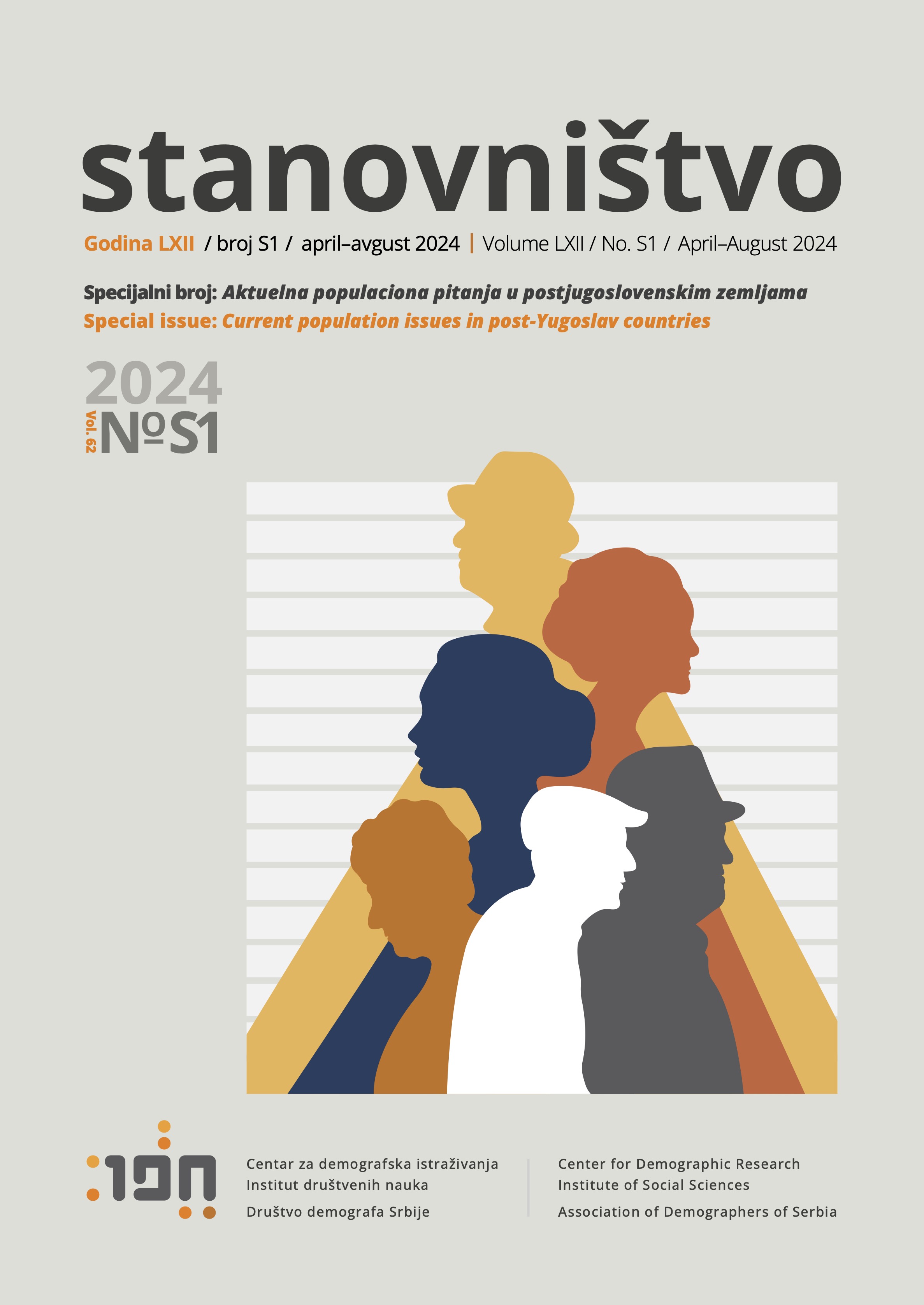Zaposlenost, rodna ravnopravnost i porodične politike: postjugoslovenske države i Evropska unija
Glavni sadržaj članka
Apstrakt
Cilj je da se sagleda u kom smeru treba poboljšavati politike u vezi sa zaposlenošću mlađe sredovečnih žena
u post-jugoslovenskim državama. U fokusu su razlike između žena i muškaraca koji nisu roditelji i razlike između žena koje imaju bar jedno dete mlađe od šest godina i žena bez dece. Komparativna analiza pokazala je da je j
edna od najvećih stopa zaposlenosti žena koje imaju decu mlađu od šest godina na nivou Evropske unije u Sloveniji (iznad 80%), a da je model nepunog radnog vremena manje zastupljen nego u većini skandinavskih i zapadno evropskih država. Zaposlenost mlađe sredovečnih žena u Srbiji je ispod proseka za Evropsku uniju, a u 2021. bilo je zaposleno manje od dve trećine žena starosti 20-49 godina, kako onih koje nisu imale decu, tako i onih koje su imale bar jedno dete uzrasta do šest godina. Potrebne su politike koje impliciraju
rodnu ravnopravnost i u pogledu nivoa i u pogledu kvaliteta zaposlenosti, što znači i rodnu ravnotežu u usklađivanju rada i roditeljstva, uključivanje fleksibilnih radnih aranžmana, ali i
poboljšanje zaposlenosti žena koje nemaju decu.
Preuzimanja
Detalji članka

Ovaj rad je pod Creative Commons Autorstvo-Nekomercijalno 4.0 Internacionalna licenca.
Centar za demografska istraživanja Instituta društvenih nauka
Reference
Avlijaš, S. (2016). Vicious and Virtuous Cycles of Female Labour Force Participation in Post-Socialist Eastern Europe. LEQS Paper No. 119. http://dx.doi.org/10.2139/ssrn.2865141 DOI: https://doi.org/10.2139/ssrn.2865141
Avlijaš, S. (2017). Revisiting the Baltic growth model: From neoliberalism to the social investment welfare state, Sciences Po LIEPP (Working Paper n°66, 2017-04-21). https://www.researchgate.net/publication/316438276_Revisiting_the_Baltic_growth_model_From_neoliberalism_to_the_social_investment_welfare_state
Avlijaš, S. (2019). Growth Models and Female Labor in Post-Socialist Eastern Europe. Social Politics: International Studies in Gender, State & Society, 27(3), 1–28. https//doi:10.1093/sp/jxz012 DOI: https://doi.org/10.1093/sp/jxz012
Babović, M. (2010). Rodne ekonomske nejednakosti u komparativnoj perspektivi. Beograd: Sociološko udruženje Srbije i Crne Gore i Institut za sociološka istraživanja Filozofskog fakulteta. https://isi.f.bg.ac.rs/wp-content/uploads/2019/04/Marija-Babovic-Rodne-nejednakosti.pdf
Balon, B. (2007). Rodno senzitivna statistika kao neophodan element u demokratizaciji društva. Stanovništvo, 45(1), 79-95. https://doi.org/10.2298/STNV0701079B DOI: https://doi.org/10.2298/STNV0701079B
Caselli, G., & Egidi, V. (2007). The Need for a Multi-Disciplinary Approach. Population-E, 62(1), 33-38. https://doi.org/10.3917/pope.701.0033 DOI: https://doi.org/10.3917/pope.701.0033
Ciccia, R., & Bleijenbergh, I. (2014). After the Male Breadwinner Model? Childcare Services and the Division of Labor in European Countries. Social Politics, 21(1) 50–79. https//doi.org/10.1093/sp/jxu002 DOI: https://doi.org/10.1093/sp/jxu002
Coast E. E., Hampshire, K. R., & Randall, S. C. (2007). Disciplining anthropological demography. Demographic Research, 16(16), 493-518. https://doi.org/10.4054/DemRes.2007.16.16 DOI: https://doi.org/10.4054/DemRes.2007.16.16
Del Boca, D., Pasqua, S., & Pronzato, C. (2005). Fertility and Employment in Italiy, France and UK. Labor, 19(Special Issue), 51-77. https://doi.org/10.1111/j.1467-9914.2005.00323.x DOI: https://doi.org/10.1111/j.1467-9914.2005.00323.x
European Commission (2020). Gender equality strategy. https://commission.europa.eu/strategy-and-policy/policies/justice-and-fundamental-rights/gender-equality/gender-equality-strategy_en
European Commission (2022). Proposal for a Council Recommendation on the Revision of the Barcelona Targets on early childhood education and care. eur-lex.europa.eu/legal-content/EN/TXT/PDF/?uri=CELEX:52022DC0442
Eurostat (2024). Households statistics – LFS series. Reference metadata in Euro SDMX Metadata Structure (ESMS). https://ec.europa.eu/eurostat/cache/metadata/en/lfst_hh_esms.htm
Eurostat (2023a). Employment rate of adults by sex, age groups, educational attainment level, number of children and age of youngest child (%). Statistics | Eurostat (europa.eu), preuzeto 20. novembar 2023.
Eurostat (2023b). Percentage of part-time employment of adults by sex, age groups, number of children and age of youngest child (%). Statistics | Eurostat (europa.eu), preuzeto 28. novembra 2023.
Fraser, N. (1994). After the family wage – Gender equity and the welfare state. Political theory, 22(4), 591-619. https://ezproxy.nb.rs:2213/stable/192041 DOI: https://doi.org/10.1177/0090591794022004003
Heady, P. (2007). What can anthroplogical methods contribute to demography – and how? Demographic Research, 16(18), 555-558. https://doi.org/10.4054/DemRes.2007.16.18 DOI: https://doi.org/10.4054/DemRes.2007.16.18
Hobcraft, J. (2007). Towards a scientific understanding of demographic behaviour. Population, 62(1), 47-52. https://doi.org/10.3917/pope.701.0047 DOI: https://doi.org/10.3917/pope.701.0047
Hofäcker, D., Stoilova, R., & Riebling, J. R. (2013). The dered Division of Paid and Unpaid Work in Different Institutional Regimes: Comparing West Germany, East Germany and Bulgaria. European Sociological Review, 29(2), 192–209. http://www.jstor.org/stable/24479963 DOI: https://doi.org/10.1093/esr/jcr055
Johnson-Hanks, J. (2007). What kind of theory for antropological demography? Demographic Research, 16(1), 1-26. . https://doi.org/10.4054/DemRes.2007.16.1 DOI: https://doi.org/10.4054/DemRes.2007.16.1
Kolin, M., & Čičkarić, L. (2010). Ekonomska i politička participacija žena u Srbiji u kontekstu političkih integracija. Beograd: Institut društvenih nauka.
Orloff, A. S (1993). Gender and the Social Rights of Citizenship: The Comparative Analysis of Gender Relations and Welfare States. American Sociological Review, 58(3), 303-328. https://ezproxy.nb.rs:2213/stable/2095903 DOI: https://doi.org/10.2307/2095903
Organization for Economic Co-operation and Development (2024). OECD Data. Part-time employment rate. https://data.oecd.org/emp/part-time-employment-rate.htm
Radivojević, B. (2015). Ekonomske strukture stanovništva. U V. Nikitović (Ur.), Populacija Srbije početkom 21. veka (pp. 222-261). Beograd: Republički zavod za statistiku. https://publikacije.stat.gov.rs/G2015/Pdf/G20154006.pdf
Republički zavod za statistiku Srbije (2019). Koncepti zaposlenosti – registrovana i anketna zaposlenost, 2017. Metodološka objašnjenja i ostali materijali. https://www.stat.gov.rs/sr-latn/istrazivanja/methodology-and-documents/?a=24&s=2400
Ristovski, A., & Kalamatiev, T. (2023). Pristup radnog prava EU rešavanju problema zaposlenih roditelja i negovatelja. Stanovništvo, 61(2), 109–127. https://doi.org/10.59954/stnv.555 DOI: https://doi.org/10.59954/stnv.555
Saraceno, C. (2011). Gender (In)equality: An incomplete revolution? Cross EU similarities and differences in the gender specific impact of parenthood. Berlin: Harriet Taylor Mill-Institute (HTMI) of the Berlin School of Economics and Law (Discussion Paper 13, 3/2011). https://www.researchgate.net/publication/261062906_Gender_Inequality_An_Incomplete_Revolution_Cross_EU_Similarities_and_Differences_in_the_Gender_Specific_Impact_of_Parenthood
Scharle, A. (2007). The effect of welfare provisions on female labour supply in Central and Eastern Europe. Journal of Comparative Policy Analysis: Research and Practice, 9(2), 157-174. https://doi.org/10.1080/13876980701311596 DOI: https://doi.org/10.1080/13876980701311596
Šobot, A. (2014a). Rodna neravnopravnost u Srbiji - demografsko gledište, Beograd: Institut društvenih nauka. https://idn.org.rs/monografije-2014/
Šobot, A. (2014b). The Economic Activity of Middle-aged Women in Serbia as one of the Relevant Issues Regarding Gender Equality. Zbornik Matice srpske za društvene nauke, 148(3), 499-510. https://doi.org/10.2298/ZMSDN1448499S. DOI: https://doi.org/10.2298/ZMSDN1448499S
Tabutin, D. (2007). Whither demography? Strenghts and Weaknesses of the Discipline over Fifty Years of Change. Population-E, 62(1), 15-32. https://doi.org/10.3917/pope.701.0015 DOI: https://doi.org/10.3917/pope.701.0015





